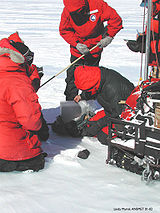- Meteorite hunter
-
A meteorite hunter is a person that searches for meteorites.
Meteorite hunters may be amateurs who search on the weekends and after work, or professionals who recover meteorites for a living. Both frequently utilize tools such as metal detectors to discover the meteorites. If the meteorite is of the iron or stony iron variety a metal detector will detect it through many inches of soil. Stony meteorites - which make up the large majority of meteorites that fall – may not have a high enough nickel iron content to set off a metal detector. Large and very sensitive metal detectors may be used as well as ground-penetrating radar, lidar, and even landmine detectors.[1] Although meteorites fall uniformly across the globe they do not remain on the surface in areas with a large amount of yearly rainfall. If a newly fallen meteorite is not recovered within a few months it is likely to be buried under mud or covered over by plant growth. Arctic and desert regions have proven particularly suited to meteorite hunting.
Meteorites can be very valuable to scientists studying planetology and to collectors. Individual stones may weigh mere grams or hundreds of kilograms. Their values can reach US$ 1 million.[2] Meteorites which can be proven to have struck a man-made object are called hammer stones and are more valuable. Even the objects they hit are highly prized.[3]
Contents
Meteorite hunting and the law
Private lands
In the United States, most state laws provide that a meteorite find belongs to the landowner upon which the meteorite was found.[4] This doctrine contrasts with the once-predominant rule in state courts on the finding of treasure trove, where buried gold or silver coinage (or paper money representing the same) is deemed to belong to the finder.
State lands
Many state courts have interpreted their laws as granting the state sole title to any meteorite recovered on state-owned lands.
Federal lands
United States laws and enforcement of laws regarding recovery of meteorites on federally-owned public lands is unsettled. With respect to large meteorites, the federal government has asserted title to all such meteorites if proven to be found on federal land, because a) the meteorite is the property of the federal government, the landowner, b) because meteorites found on public lands are subject to the 1906 Antiquities Act (16 U.S.C. 432), and c) the meteorite does not qualify as a “valuable mineral” as defined under the 1872 Mining Law, thus not subject to mineral claim rights that could otherwise be filed by the discoverer.[5] This policy derives from cases as far back as 1944, when the federal government seized the Drum Mountain Meteorite in Utah from a group of interned Japanese-American U. S. citizens. The federal government has sometimes agreed to negotiate sometimes negotiating a small finders fee for large meteorites, but has never agreed to pay anything resembling full market value of the meteorite to the discoverer.
In the case of small meteorites, ownership of meteorites found on federal land is not covered in the Code of Federal Regulatons, and in the past hobbyists have bee able to remove small quantitites of rock for non-commercial use.[6] However, in recent years the U.S. Bureau of Land Management (BLM) has asserted that it owns all meteorites recovered on BLM land, apparently arguing that BLM stands in the same position as a private landowner under state law.[7] The BLM further asserts that under the 1906 Antiquities Act, all meteorites on BLM land belong to the Smithsonian Institution.[8] This broad new interpretation of the law excludes the public from any possibility of owning or being paid for the meteorites they discover. While ostensibly designed to restrict meteorite recovery on public lands to authorized scientific personnel who will turn over their finds to the proper government agency as custodian, in practice this law means few meteorites discovered by the public will ever be turned over to the authorities.[9] In some cases, the law could result in dooming otherwise discoverable meteorites to continue to decompose in the ground, because the law makes it either illegal or too expensive for the amateurs (who compose the vast majority of meteorite hunters) to look for them without hope of being able to keep one's finds or be compensated for their fair market value.[10]
Media
Meteorite Men is an American television series following two meteorite hunters.
References
- ^ Rare meteorite found in Kansas field, MSNBC, Oct. 16, 2006
- ^ Million-dollar space rock unearthed, MSNBC, Nov. 11, 2005
- ^ Lorton Meteorite Fall: Meteorite Smashes Through Doctors Roof!
- ^ Goddard v. Winchell, 86 Iowa 71; 52 N.W. 1124; 17 L.R.A. 788 (1892): In Goddard, a meteorite fell on land owned by Goddard, which was excavated from Goddard's property by a third party and sold to Winchell, who sought to claim sole title to it. The court ruled that the meteorite became a part of the land where it arrived through natural causes, and title vested solely in the landowner, Goddard.
- ^ People of the State of California et al v. Mead, 618 F.2d 618 (1980)
- ^ Norton, O. Richard, Field guid to meteors and meteorites, London: Springer-Verlag, ISBN 09781848001655 (2008), p. 196
- ^ Bureau of Land Management, Rockhounding on Public Land: Meteorites, retrieved 8 May 2011
- ^ Bureau of Land Management, Rockhounding on Public Land: Meteorites, retrieved 8 May 2011
- ^ Norton, O. Richard, Field guid to meteors and meteorites, London: Springer-Verlag, ISBN 09781848001655 (2008), p. 196
- ^ Norton, O. Richard, Field guid to meteors and meteorites, London: Springer-Verlag, ISBN 09781848001655 (2008), p. 196
External links
Categories:- Meteorites
- Collecting
Wikimedia Foundation. 2010.


